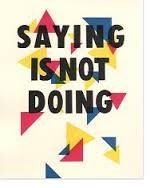
I love this post from Seth Godin, as it not only captures my experience with opinions, but it is also an important point for you to consider in major gifts:
It doesn’t matter what people say. Watch what they do.
The story is told of a focus group for a new $100 electronic gadget. The response in the focus group was fabulous, people all talked about the features of the new device with excitement.
At the end of the session, the moderator said, “Thanks for coming. As our gift to you, you can have your choice of the device or $25.”
Everyone took the cash.
Surveys that ask your customers about their preferences, their net promoter intent, their media habits—they’re essentially useless compared to watching what people actually do when they have a chance. The media wastes their time and ours handicapping politics based on polls, on changes in polls, on expectations based on polls—it’s sad. Polls are always wrong.
The best part of show & tell has never been the telling part.
Jeff and I have seen more donor surveys than we can stomach, not to mention the scores of development leaders who craft their major gift strategies on the opinions of others rather than on the actual behavior of donors.
Our bias in this direction comes from our direct marketing background where we measured everything. Everything. We tested channels, donor offers, creative approaches, seasonality, gift amounts and scores of other variables in the fundraising transaction. Why did we test? To see what the donor would DO.
In major gifts, when you are trying to figure out what works, the best source of information is your donor. While it is helpful to pay attention to the experiences of others (our info, and that of other advisors), nothing trumps the personal knowledge you can secure from each individual donor on your caseload and the personal information you can observe about what the donor does.
This is why we are constantly talking about securing basic and important information from your donor like:
- Their passions and interests – what are they really interested in?
- Their communication preferences – do they prefer in-person meetings, or email, phone, etc.?
- What information they want to receive from you?
- Personal info on family, hobbies, politics, etc.
- What bugs them and impresses them about non-profits?
- …and anything else you can secure that helps you understand the donor and how to relate and serve her outrageously.
Each one of the donors on your caseload is a unique individual with very special characteristics, leanings and preferences. You must get to know each one (through information plus observation of behavior) so you can be effective in serving them.
There are two important points about the information you secure from your donor:
- You are not securing this information to manipulate and maneuver the donor toward your ends. You are securing it to understand who the donor is, so you can do the right things in your relationship.
- Once you have secured the information and you are using it to inform and shape your strategies with the donor, you need to observe carefully what the donor DOES and let that be your guide as to the accuracy and practicality of the information the donor gave you. Here’s an example of what I mean: a donor told a MGO not to send him any information that had emotional stories or pictures. He strongly stated: “I do not like that tactic and feel you are trying to manipulate me when you do it.” So the MGO started editing what she sent to this donor, extracting all the real-life experiences of the people the organization served and reducing the communication down to sterile, cold numbers and words. The result? Nothing. No action. No engagement. No giving. Nothing. Then the MGO decided to change course. And knowing the interests and passions of this donor, she sent him a real life story of a person who needed help. The result? Engagement and a gift, plus a deeper and more meaningful relationship between the donor and the MGO.
There is a fine line between taking what a donor says at face value, following it blindly and without question, and using your judgment and discerning a course of action that represents how the donor really feels. You must walk this line very carefully, showing respect and maintaining integrity.
So let’s return to what Seth said at the top of this writing. Know your donor, THEN pay attention to what the donor does. That is what will guide your path.
Richard





0 Comments
Trackbacks/Pingbacks